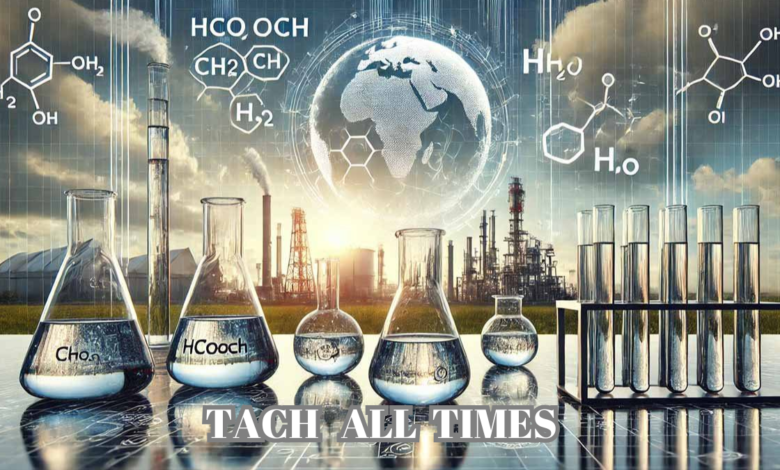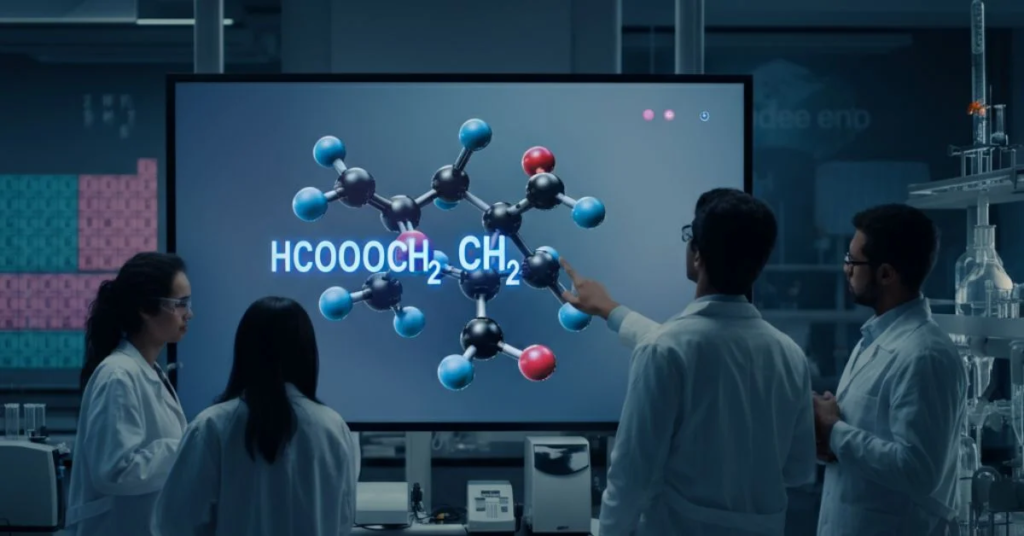HCOOCH CH₂ H₂O: Unpacking the Chemistry Behind This Intriguing Compound

Introduction
Chemistry is full of fascinating compounds, and one such combination is HCOOCH CH₂ H₂O. Though it may look like a random string of elements, this group represents the interaction between methyl formate (HCOOCH₃), methylene (CH₂), and water (H₂O)—three important components in both organic and industrial chemistry. Together, they illustrate the delicate balance and reactivity found in organic reactions.
Understanding the role of each component helps chemists, researchers, and industry professionals manipulate reactions to produce fuels, plastics, fragrances, and more. Methyl formate is widely used in synthetic processes, methylene acts as a highly reactive intermediate, and water often plays a crucial role as a solvent or reactant. HCOOCH CH₂ H₂O In this article, we’ll explore each component in detail, how they interact, and why their reactions matter in both academic and commercial chemistry.
This informative guide is crafted to help you not just understand these compounds but appreciate the chemistry that binds them. From the basics of each molecule to their role in chemical reactions, safety practices, and environmental impacts, you’ll gain a comprehensive perspective. Let’s dive into the science behind HCOOCH CH₂ H₂O.
Understanding the Chemical Components
1.1 What is HCOOCH (Methyl Formate)?
Methyl formate, or HCOOCH₃, is an ester formed by the reaction of formic acid (HCOOH) with methanol (CH₃OH). It has a pleasant odor and is often found in perfumes and flavorings. Structurally, methyl formate consists of a formyl group (HCO-) attached to a methoxy group (-OCH₃), making it one of the simplest esters in organic chemistry.HCOOCH CH₂ H₂O
This compound is not only lightweight and volatile but also flammable, which makes it useful in industrial applications like blowing agents for foam manufacturing and solvents for paints and adhesives. In nature, methyl formate is present in some plants and fruits, contributing to their fragrance. It’s also detected in outer space, which adds to its intrigue among astrochemists.
In chemical synthesis, HCOOCH acts as an intermediate for producing formamide, formic acid, and other derivatives. It’s appreciated for its ability to engage in nucleophilic substitution and hydrolysis reactions. Because of its polarity and low boiling point, it’s ideal for use in processes requiring quick evaporation and easy separation. HCOOCH CH₂ H₂O
1.2 The Role of CH₂ in Organic Chemistry
The CH₂ group, also known as methylene, plays a crucial role in organic compounds. Methylene isn’t usually found in isolation—it serves as a bridge or building block between larger carbon chains. HCOOCH CH₂ H₂O It’s extremely reactive when free and is often found in the form of carbenes (CH₂:), which are highly unstable and short-lived intermediates used in organic synthesis.
In reaction mechanisms, methylene units help form alkenes, alkanes, and various ring structures. For instance, they’re essential in cyclopropanation reactions, where a CH₂ group adds to a double bond, forming a three-membered ring. This makes CH₂ a star player in pharmaceuticals, polymers, and dye industries. HCOOCH CH₂ H₂O
Furthermore, CH₂ groups are pivotal in increasing the length and flexibility of carbon chains. In biochemistry, they form part of fatty acid chains and amino acids, influencing the hydrophobic or hydrophilic nature of biomolecules. HCOOCH CH₂ H₂O Their versatility in bonding and reactivity makes methylene groups indispensable in the world of organic chemistry.
1.3 H₂O: The Universal Solvent
Water (H₂O) is arguably the most important compound in chemistry. Known as the universal solvent, its unique polarity allows it to dissolve a wide range of substances. In the context of HCOOCH CH₂ H₂O, water plays multiple roles—it can act as a reactant, a medium for reactions, or a hydrolyzing agent.
In ester hydrolysis, for example, water breaks down HCOOCH into methanol and formic acid under acidic or basic conditions. This reaction is crucial in many industrial processes like soap making (saponification) and biodegradable plastic development. HCOOCH CH₂ H₂O Water’s role doesn’t stop at being a solvent—it actively participates in reactions, influencing equilibrium and reaction rates.
Its dipole nature allows water molecules to stabilize ions and transition states, making reactions more efficient. In organic chemistry, water also helps regulate temperature and pH during exothermic reactions. Understanding water’s behavior in combination with methyl formate and methylene is key to mastering many organic reaction pathways.
Chemical Reactions and Interactions

2.1 Potential Reactions Involving HCOOCH, CH₂, and H₂O
When combined, HCOOCH, CH₂, and H₂O can undergo a variety of reactions. One of the most common is acid or base-catalyzed hydrolysis, HCOOCH CH₂ H₂O where methyl formate reacts with water to yield formic acid and methanol. This is a reversible reaction often used to produce cleaner fuels and solvents.
CH₂, when introduced as a reactive species such as a carbene, can interact with HCOOCH to form more complex structures like ethers or cyclic esters. HCOOCH CH₂ H₂O This makes it valuable in synthesizing fine chemicals and intermediate compounds in pharmaceuticals.
When all three components are present, multi-step reactions can occur. For instance, under catalytic conditions, a methylene group might insert into a C-H bond of methyl formate, creating a longer-chain ester. The water then helps shift the equilibrium or hydrolyze the product further depending on the conditions. This is why the trio of HCOOCH CH₂ H₂O holds significant interest in research labs.
2.2 Real-World Applications of These Reactions
The interaction of these compounds isn’t just theoretical—it has real-world implications. In the petrochemical industry, such reactions are used to develop alternative fuels and lubricants. Methyl formate serves as a cleaner replacement for traditional chlorinated solvents, and its ability to undergo controlled hydrolysis makes it ideal for green chemistry applications.
CH₂-based reactions, especially those involving carbenes, are foundational in the creation of pharmaceutical precursors and agrochemicals. These compounds often require selective functionalization, which methylene can provide. HCOOCH CH₂ H₂O Water’s role in safely moderating these reactions further emphasizes its importance.
Additionally, such reactions help create biodegradable plastics and eco-friendly foams. Methyl formate is commonly used as a blowing agent for polyurethane foams, while controlled addition of CH₂ units can alter flexibility and degradation rates. All this points to how chemistry rooted in simple compounds can lead to transformative applications.
Safety, Storage, and Environmental Impact
3.1 Handling and Storage Guidelines
Although methyl formate and methylene are incredibly useful, they are also potentially hazardous. HCOOCH is flammable and should be stored in cool, well-ventilated areas away from heat sources. Containers must be tightly sealed to prevent vapor accumulation, which could lead to fire hazards. Protective equipment like gloves and goggles is essential during handling.
CH₂ compounds, particularly carbenes, are highly reactive and usually generated in situ. Their handling requires advanced lab setups with proper fume hoods and reaction controls. HCOOCH CH₂ H₂O Water, while benign, can pose risks in reactions involving reactive esters or free radicals, making careful temperature control a necessity.
3.2 Environmental Concerns
From an environmental perspective, methyl formate breaks down relatively quickly, posing minimal risk when handled correctly. However, its production and disposal must follow eco-friendly guidelines to prevent volatile organic compound (VOC) emissions. HCOOCH CH₂ H₂O CH₂ intermediates, due to their high reactivity, do not persist in the environment but can form by-products that may be harmful if not properly managed.
Water’s role in environmental reactions is more complex—it can carry pollutants if not managed. Therefore, wastewater from organic reactions involving HCOOCH CH₂ H₂O must be treated before disposal. Implementing sustainable chemistry principles ensures that these compounds remain beneficial without contributing to environmental degradation.
Conclusion
The combination of HCOOCH, CH₂, and H₂O opens a window into the fascinating world of organic chemistry. HCOOCH CH₂ H₂O From foundational molecular interactions to advanced industrial applications, each component brings unique properties that enable complex and valuable reactions. Methyl formate serves as a reactive ester, methylene acts as a versatile bridge in organic chains, and water facilitates these reactions with precision and efficiency.
Understanding their chemistry isn’t just about theory—it has real-world implications in green technology, fuel development, and sustainable manufacturing. Whether you’re a student, researcher, or industry professional, exploring these compounds deepens your appreciation of how simple molecules can drive big change.
Also Read: Jurgen Klopp USMNT



